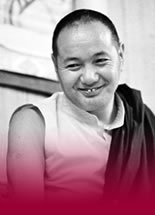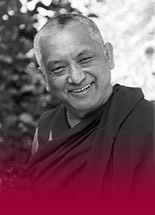Robina’s Blog
5 July, 2019
There are so many ideas in the world about what meditation is and why we would want to do it. And, I’d suggest, there are many misconceptions about it, too. The clichéd image of a person “meditating” has them sitting in full-lotus position, the incense wafting and the lights low while they go to some mystical place where all the thoughts stop. And often “meditating” is seen as a selfish activity.
But when we hear the Tibetan word for “to meditate” – gom – it translates as “to familiarize”, it really throws us. So, what is meditation? What do we need to familiarize ourselves with? The Buddha’s answer is twofold: we need to utterly familiarize our minds with, bring our minds into sync with, virtue and reality.
And why would we need to do that? Because right now, according to the Buddhist take on the world, our minds are more familiar with the opposite: attachment, anger, jealousy and the other neuroses – just look at the suffering all around us: in our own selves, in our relationships, in the world. It is these unhappy states of mind that cause us to be out of sync with reality and goodness, which, in turn, cause us to harm others.
Classically there are two main kinds of meditation used to accomplish freedom from these neuroses – Buddha calls this “nirvana” – this amazing state of being, the potential for which is natural within all of us. These two, both labelled according to the result, are called “calm abiding” and “insight”.
A simpler term for “calm abiding” or in Sanskrit, “samatha”, and more direct in conveying its meaning, is “single-pointed concentration”: a state of mind so subtle and refined that the constant stream of conceptual thoughts and emotions, as well as the sensory consciousness, have ceased. That sounds what we might call sleep! But in fact it’s a state of super-clear awareness. There is no such state of mind posited in modern psychology and therefore certainly no methods to accomplish it.
Why would we want to accomplish this state of samadhi, as the Hindus would call it? In the long term, for the Buddha, in order to eradicate from our minds all the voices of ego, which we consider normal but which he discovered from his own experience are not intrinsic, we need to access this subtle state, this microscope of our mind.
So extraordinary is this state of samadhi – absolute clarity, bliss, clairvoyance, and effortless control over thoughts and emotions – that it can easily be mistaken as the end result in itself. But for the Buddha it’s just the beginning, it’s merely a tool that is then used to develop insight, or in Sanskrit, vipassana, the goal of the second mode of meditation.
Insight into what? Reality, how things actually exist. This sounds pretty abstract but what’s implied is that the more we’re caught up in the self-centred fear-based self, the more we see everything through the filter of the voices of this unreal self, attachment, anger, depression and the rest, and the more out of touch with reality everything appears to us.
The development of insight into reality is no easy job, but it’s attainable, just naturally.
Most of us won’t get very far in this life with even the first mode of meditation, concentration – forget about the second, the development of insight. But we need to start somewhere. Even five minutes a day of determined, clear focus on something as simple as the breath going in and out of our nostrils can help us step out of our heads and strengthen our clarity, our focus, our thus our ability to see more clearly what’s going on inside ourselves.
Then we can apply the second mode of meditation and do some internal analysis, be our own therapist: recognize the fears and unhappy attitudes and use our wisdom and intelligence and kindness etc. to argue with them and gradually lessen them. We can mould our mind, as Lama Zopa Rinpoche says, into any shape we like.
Then, out of our meditation, we can make more sense of what’s going on around us, seeing things more objectively, and seeing others through the filter not of our fears and neuroses but our empathy and kindness.
This is the perfect application in daily life of the modes of meditation.
Eventually, perfection will come. One step at a time.

